The Microsoft Lumia 640 Review
by Brandon Chester on June 9, 2015 8:00 AM EST- Posted in
- Smartphones
- Microsoft
- Mobile
- Lumia
- windows phone 8
System Performance
Since the state of benchmarking on Windows Phone is not as mature as Android, I haven’t been able to compare the Lumia 640 to the competition in every aspect that I would like to. What I have been able to do is put it through our standard browser benchmarks, along with BaseMark OS II to look at individual component performance, and GFXBench to examine GPU performance.
While the absolute performance of Snapdragon 400 is well known, certain aspects of performance are heavily impacted by a device’s software. A good example is browser performance, which is a function of both SoC power and the speed of a device’s browser and Javascript engine. Two devices with the same SoC can have very different browser performance.
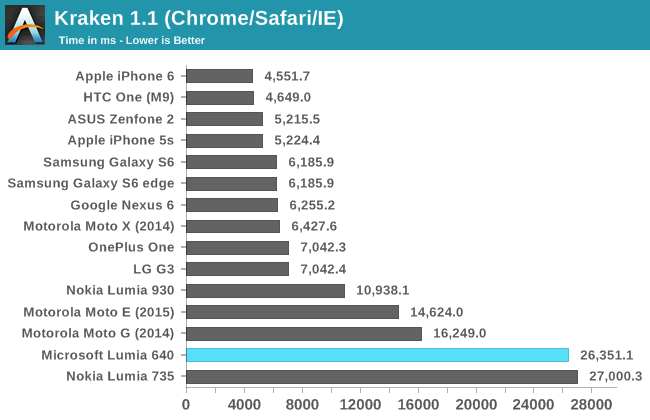
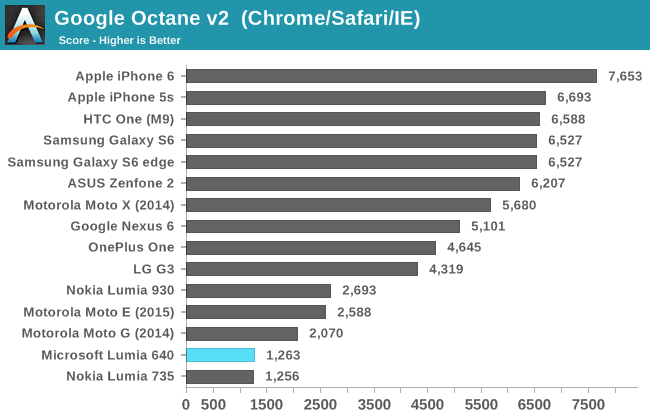
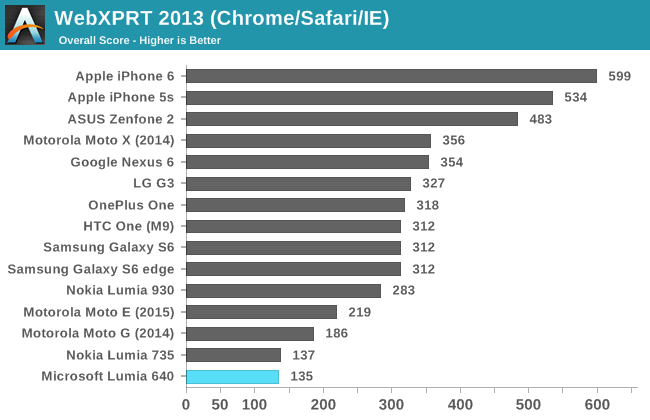
Unfortunately, it’s clear that Internet Explorer doesn’t measure up to Chrome and Safari when it comes to performance. While buyers may be pleased that their Lumia 640 performs as well as the more expensive Lumia 735, both of these phones occupy the lowest positions on every chart. There’s even a significant gap between them and other Snapdragon 400 devices running Android, such as Motorola’s Moto G.
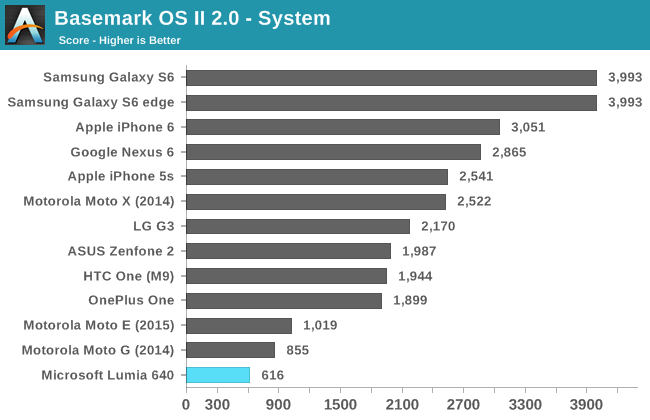
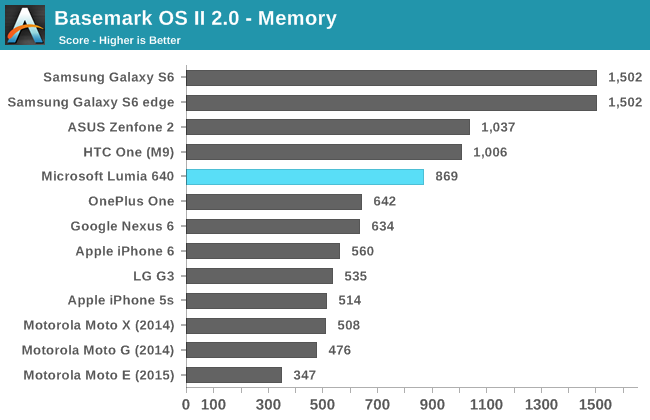


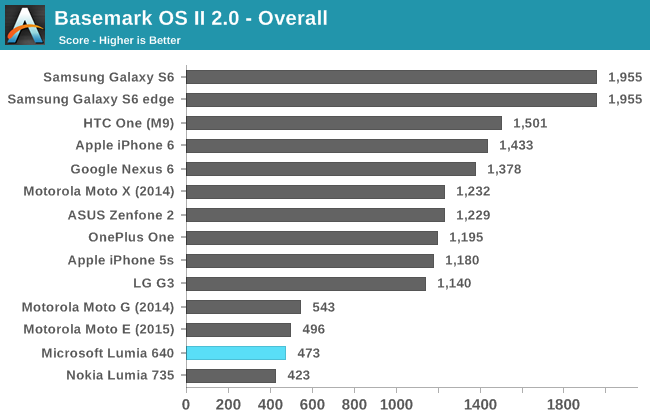
There's not much need to go into detail on the Lumia 640's performance in BaseMark OS II. With the exception of a fairly good result in the NAND memory test, the Lumia 640 achieves the lowest scores that we've seen in recent times.
Unfortunately, the Lumia 640 isn't shaping up to be a very quick device. It's consistently bested by Snapdragon 400 devices running Android, and in 2015 we're going to see Snapdragon 410 used as the SoC of choice in devices at this price bracket, which won't make the Lumia 640's position any better. Microsoft needs to iterate much quicker than they currently are. Their slow pace in adoption new hardware helped kill Windows Phone in the high end market, and it will do the same to the low end. I have some further words about performance on the Lumia 640 and Windows Phone in general, but those will have to wait until the software section of the review.
GPU Performance
The last area of performance to investigate is GPU performance. The performance of Adreno 305 has been thoroughly evaluated on Android, but differences in drivers and graphics APIs can improve or reduce performance across different operating systems.
Since Adreno 305 doesn’t support Direct3D feature level 10.0 and Shader Model 4.0 it’s unable to run the GFXBench 3.0 Manhattan test. This leaves us with only the T-Rex HD benchmark which isn’t very hard on high end devices, but still poses quite a challenge for weaker mobile GPUs.
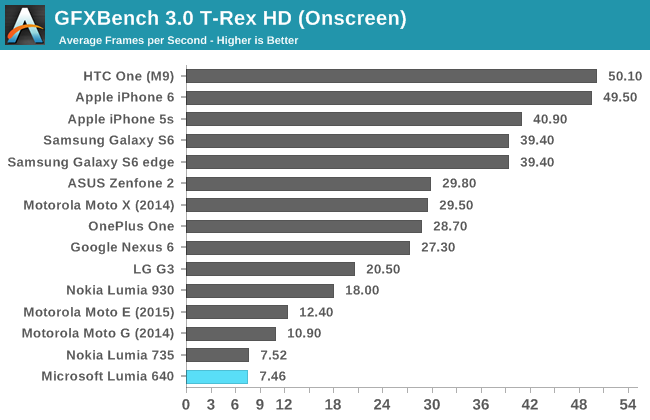
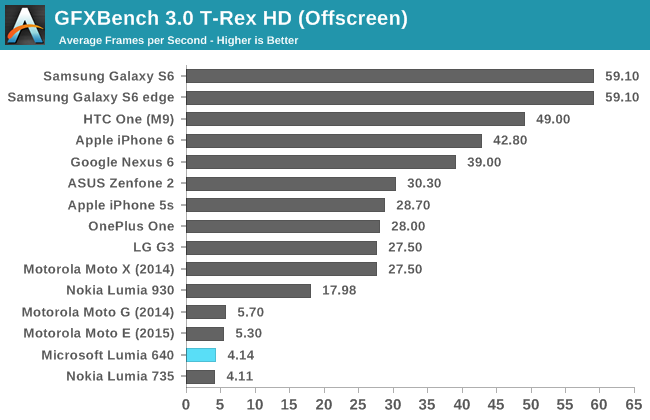
In both the on-screen and off-screen tests, the Lumia 640 lags behind the Moto G. While 1-2fps doesn’t seem like much, when your frame rate is in the low single digits it represents a significant difference in performance. Because of this, I decided to take a look at the performance in GFXBench’s driver overhead test to see what impact the GPU drivers and graphics API might have on performance.
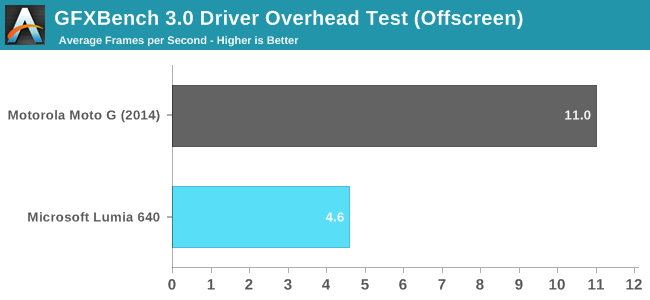
As suspected, there’s a very significant gap in performance when comparing the Lumia 640 to the Moto G. I can’t say whether this is due more to the differences between OpenGL and DirectX, or between the different Adreno drivers on Windows Phone and Android, but whatever the case may be the end result is a notable decrease in GPU performance on Windows Phone when compared to an Android device with the same SoC.
I’m not happy at all with the GPU performance that we see in low-end and even mid-range smartphones, and the Lumia 640 is no exception. There’s not much Microsoft can do here though, as moving to Snapdragon 410 with its Adreno 306 will not improve GPU performance at all. All I can really say is that users shouldn’t expect to be playing any 3D games on their Lumia 640, but simpler 2D games should run just fine.










130 Comments
View All Comments
lolstebbo - Tuesday, June 9, 2015 - link
"Since this Lumia 640 is locked to Cricket Wireless, I'm unable to also test it on LTE, which is unfortunate."Why would the 640 being locked to Cricket prevent you from testing it on LTE?
Brandon Chester - Tuesday, June 9, 2015 - link
Because I'm Canadian.milkod2001 - Tuesday, June 9, 2015 - link
MS has less then 5% mobile market share...What will break this curse?
1) another crappy low end phone? - NO
2) high end Samsung / Apple like specs phone with better camera, mSD+rem. battery? - YES
(MS needs to make killer phone people will talk about and think about getting )
3) fixing missing apps -YES
(MS as giant software company can not make the same in house apps as most popular Android / iOS apps? Or just pay developers to make the same apps for Windows Phone? How pathetic is that?)
colguy1 - Tuesday, June 9, 2015 - link
Don't you think MS has not attempted to do that? Back in 2013 MS created a very beautiful Youtube app. I used it for a week in my Windows Phone. But Google made sure that it was removed from the windows phone store. Well known Windows Phone developer Rudy Huyn created an amazing client app for SnapChat. But when SnapChat removed all 3rd party apps, it removed this app too. This SnapChat app was miles better than the first party apps in iOS and Android. The developer requested many times to work with him to whitelist the app and get it in the Windows Phone store. But no response from the SnapChat. MS created a Pebble app and demoed it to the Pebble guy.. Little bit of google search will tell you what happened next.. It is not just entirely MS fault for the lack of apps.jakoh - Thursday, June 11, 2015 - link
I can say to for no 3, the new cross compiling feature in windows 10 which will allow Java or Objective C to be compiled for Windows will help.Harry_Wild - Thursday, June 18, 2015 - link
Microsoft needs to get out of the U.S. carrier exclusivity agreement with their high end models. Many people now go with unlock international models that live in the U.S. Total bizarre that Microsoft's home market; they screw the consumer in flavor of the carrier!mockyboy - Tuesday, June 9, 2015 - link
I need a new non-contract phone and have been considering an Iphone. I have a Lumia 521 right now and even as a casual phone user it's gotten way too slow.The thing is whether the Iphone is worth the 5x higher price than the 640. I can get the 640 and an Ipad Mini for around 420 and still save $200. And I work from home, so honestly I'm really not a heavy phone user. The 640 seems like it would be fine for everyday needs, and the few apps I want I can get a Ipad Mini for.
StormyParis - Tuesday, June 9, 2015 - link
Frankly, I'd get a Moto E or G instead. Here's Anand's Moto E conclusion: http://www.anandtech.com/show/9129/the-moto-e-2015...mockyboy - Tuesday, June 9, 2015 - link
I hadn't considered those, thanks. Although for some reason I've been avoiding Android. I have no idea why. Maybe because I heard bad things about their low end phones, but based on that review I guess that's changed.Callum S - Tuesday, June 9, 2015 - link
Either that or get a Lumia 640 and Surface 3 with accessories for about the same price as an iPhone by itself. I do however seem to be addicted to OneNote though :-)Understand completely in regards to not being a heavy phone user. It doesn't matter how powerful they get, for actually getting stuff done, there is no comparison to using either a mouse and keyboard or a stylus (for diagrams and notes). Until of course phones are at stage where they can be docked and or properly utilise other input methods like the notebooks and tablets can today.